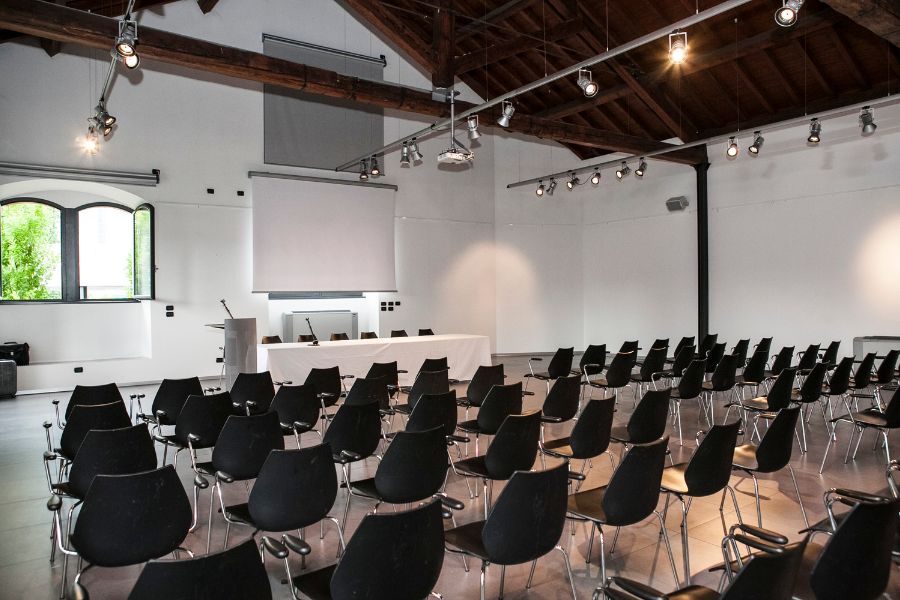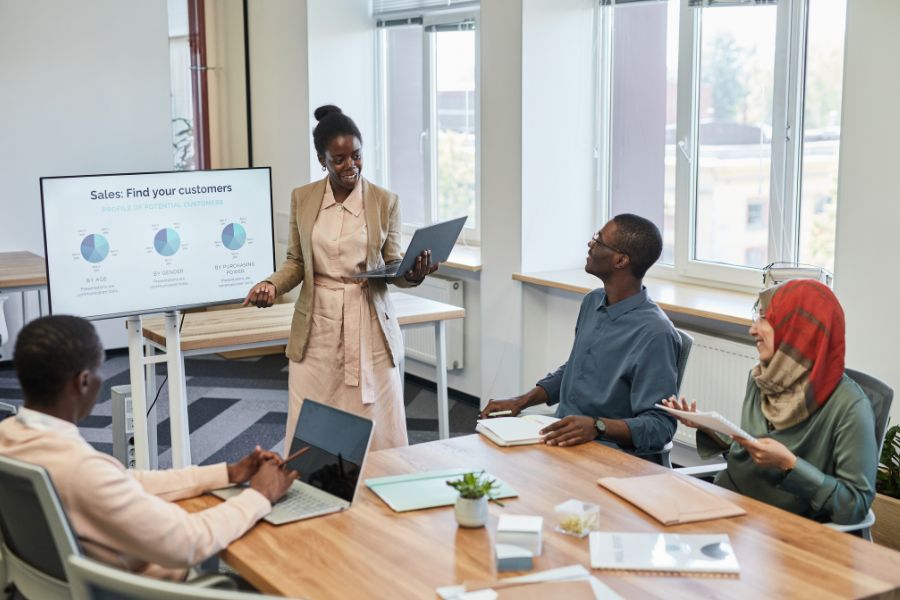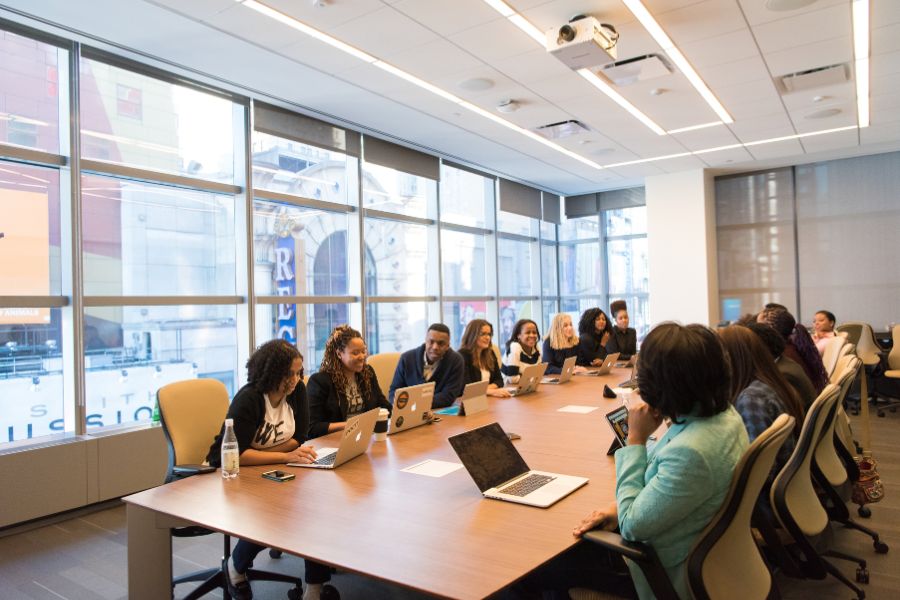Selecting the right conference room setup is one of the most critical decisions when planning a business event. Whether you’re organizing a corporate meeting, a training seminar, a networking session, or a large-scale conference, the layout of your room directly impacts engagement, communication, and the overall success of your event.
A well-designed conference meeting room setup promotes interaction, supports seamless technology integration, and ensures that every participant feels comfortable and involved. However, not all events are created equal—each has its own goals, audience, and logistical needs. Choosing the wrong layout can result in disengaged attendees, poor visibility, limited interaction, or even technical complications.
For instance, a hands-on training session may call for a classroom-style arrangement that supports note-taking and screen visibility, while a keynote or panel discussion might be better suited to a theater-style layout for optimal audience focus. In today’s hybrid work culture, incorporating technology—such as a conference room monitor setup or a video conferencing configuration—is often essential to connect remote teams or guest speakers.
To explore flexible and professional solutions tailored to your specific needs, you can check out ACE Events, a trusted provider of event spaces and services designed to elevate your corporate gatherings.
This guide will walk you through the most common conference room setups, the pros and cons of each, and the key factors to consider when selecting the ideal layout for your event. With the right setup, you’ll create a dynamic and productive environment that supports your goals and leaves a lasting impression on attendees.

Understanding Different Conference Room Setups
Selecting the right conference room setup is essential to ensure a seamless experience that aligns with the event’s goals. The choice of conference meeting room setup depends on factors such as audience engagement, communication flow, and the type of activities planned. Different conference room setups cater to various event formats, from executive meetings and corporate training sessions to large-scale conferences and networking events. To ensure a seamless and well-structured conference room setup, consider partnering with venues that offer flexible layouts and modern amenities. Explore the tailored event spaces available at ACE Events to find the perfect setting for your next corporate meeting or conference.
To ensure the optimum configuration of your conference room, it’s essential to choose the right layout for your needs. You can consult this comprehensive guide to conference room configurations to discover best practices and tips on layout and equipment. Below, we explore the most commonly used event room arrangements, detailing their benefits, best use cases, and considerations for implementation.
Boardroom Style
The boardroom style setup is one of the most traditional arrangements used for high-level executive meetings and corporate discussions. This layout features a large central table with chairs positioned around it, allowing for direct face-to-face interaction among participants.
This setup fosters an environment of collaboration and decision-making, making it particularly suitable for strategy meetings, leadership briefings, and board discussions. The close seating arrangement encourages open dialogue and ensures that every participant has an equal opportunity to contribute.
While highly effective for small groups, the boardroom style is not ideal for events that require audiovisual presentations or large audiences. Additionally, if the table is too long, it can hinder communication between participants seated at opposite ends. To counter this, organizers may integrate conference room monitor setup solutions, such as screens or projectors, to improve visibility and engagement.
Theater Style
The theater-style setup is designed to maximize seating capacity while focusing attention on a central stage or presentation area. In this arrangement, chairs are aligned in straight rows, all facing the front, much like a theater or auditorium.
This layout is perfect for large presentations, keynote speeches, and corporate events where attendees are primarily listening rather than engaging in discussions. It allows for efficient space utilization, making it a preferred choice for events with a high number of participants.
However, one limitation of the theater-style setup is that it does not facilitate group interaction or note-taking, as there are no tables available. Additionally, accessibility to exits and aisles must be carefully planned to prevent congestion, especially for larger events. Integrating conference room setup for video conferencing solutions can enhance engagement for remote attendees by ensuring the speaker’s message reaches both in-person and virtual participants.
Classroom Style
A classroom-style setup includes rows of tables with chairs facing the front, allowing attendees to take notes, use laptops, and participate in structured training sessions. This layout supports learning-oriented events, where attendees need a workspace for writing or using electronic devices.
Ideal for workshops, training sessions, and seminars, this setup fosters an environment where participants can engage with the speaker while having the tools they need to stay focused. The presence of tables makes it easier to distribute handouts and provide workspace for group exercises.
Despite its advantages, a classroom-style setup requires more space per participant compared to theater-style seating. Additionally, the interaction between attendees may be limited, as the seating arrangement directs focus toward the front rather than promoting discussion among participants. To enhance engagement, incorporating conference room monitor setup options can help presenters share materials more effectively.

U-Shape Setup
The U-shape setup arranges tables in a U-formation, leaving an open space in the center while participants are seated along the outer edges. This configuration is particularly effective for interactive meetings, brainstorming sessions, and training programs, where engagement between attendees and the presenter is key.
One of the main benefits of this conference room setup is that it encourages discussion and participation, as all attendees can see and interact with one another while maintaining a clear line of sight toward the speaker or presentation screen. This setup is commonly used for workshops, leadership training, and panel discussions, as it balances both structured presentations and open dialogue.
However, the U-shape setup takes up more space compared to other arrangements, which means it is best suited for smaller groups. Additionally, seating is limited to the perimeter, which may restrict capacity. Incorporating conference room setup for video conferencing can help remote attendees follow discussions more effectively.
Banquet & Round Tables
The banquet and round table setup is designed to foster small-group discussions and networking opportunities. Attendees are seated around circular tables, creating an informal and engaging atmosphere that encourages interaction.
This layout is perfect for gala dinners, networking events, corporate retreats, and team-building activities, where attendees need to communicate and connect with multiple people throughout the event. The banquet-style arrangement also provides a social and collaborative atmosphere, making it ideal for celebratory gatherings and award ceremonies.
One challenge with banquet and round tables is that visibility to a central speaker or stage may be obstructed, particularly for those seated with their backs to the presentation area. To counter this, event planners should ensure that screens or stage setups are strategically positioned to provide clear sightlines for all attendees.
Hollow Square & Cabaret Style
The hollow square setup and cabaret style are two variations commonly used for collaborative team sessions and discussion-based events.
- The hollow square setup consists of tables arranged in a square or rectangular formation with an open center. This design promotes full-group participation, as everyone is seated around the perimeter with no designated focal point. It is often used for panel discussions, brainstorming sessions, and corporate retreats.
- The cabaret-style setup features open-ended round tables facing a presentation area. This allows attendees to engage with each other while still being oriented toward a speaker or facilitator. It is commonly used for business networking events, small conferences, and hybrid meetings.
Both of these setups enhance interaction and team collaboration, making them ideal for events where active participation and engagement are key objectives. However, they also require more floor space than traditional layouts, which should be considered when planning a venue.
Choosing the right conference room setup is essential to ensure a productive and engaging event. Whether you need a structured conference room monitor setup for a large audience, an interactive business event layout for collaboration, or a flexible meeting space design for small-group discussions, the right setup can make all the difference.
By understanding the advantages of different conference room setups and aligning them with your event objectives, you can create a seamless experience that enhances engagement, facilitates communication, and maximizes the success of your gathering.

Factors to Consider When Choosing a Conference Room Setup
Selecting the ideal conference room setup involves more than just choosing a seating arrangement. Several factors influence the effectiveness of an event, including the number of attendees, the nature of interactions, and the technical requirements. Ensuring that these elements align with the event’s goals is crucial for a smooth and productive experience.
Below, we explore the key considerations when deciding on a conference meeting room setup.
Audience Size and Seating Capacity
One of the most important factors in conference room setup planning is determining the expected number of attendees. The conference room setup for video conferencing, business meetings, or large-scale presentations must be designed to accommodate the audience comfortably without overcrowding the space.
- Small gatherings (10-20 attendees) – A boardroom setup or U-shape arrangement is suitable for intimate discussions and executive meetings.
- Medium-sized groups (20-50 attendees) – A classroom setup allows participants to take notes while staying engaged with the speaker.
- Large audiences (50+ attendees) – A theater or banquet-style setup maximizes seating while ensuring all participants have a clear view of the presentation area.
Failing to match the room size with the number of participants can lead to discomfort, disengagement, and logistical challenges. It is essential to consider event room arrangements that allow for movement, accessibility, and interaction when necessary.
Event Objectives and Interaction Level
Different conference room setups cater to varying levels of attendee participation. Understanding the nature of the event will help organizers decide on the most effective meeting space design.
- Formal presentations & keynotes – A theater-style setup works best as it directs attention to the stage or speaker.
- Workshops & training sessions – A classroom-style setup enables attendees to take notes and engage in exercises.
- Team collaboration & brainstorming – A U-shape or cabaret-style setup fosters discussion and group participation.
- Networking & informal gatherings – Banquet-style seating encourages relaxed interactions and engagement.
Ensuring that the conference meeting room setup aligns with the event’s goals is critical to keeping attendees focused and engaged. For hybrid events, integrating a conference room setup for video conferencing can enhance participation by allowing remote attendees to contribute effectively.

Audio-Visual & Technology Needs
Modern business events rely heavily on AV equipment and digital connectivity. When selecting a conference room monitor setup, it is essential to ensure that the venue provides the necessary technical infrastructure.
Key AV considerations include:
- Projection screens & monitors – Essential for displaying slides, videos, or remote participants in a conference room setup for video conferencing.
- Microphones & sound systems – Important for large events where clear audio is required for both in-person and remote attendees.
- Wi-Fi & connectivity – Crucial for live streaming, online collaboration, and digital presentations.
- Lighting & ambiance – Adequate lighting improves visibility and enhances the event’s atmosphere.
Venues with built-in AV solutions offer a seamless experience, but if external equipment is required, organizers should ensure compatibility with the business event layouts planned.
Venue Space & Accessibility
Selecting the right conference room setup also depends on the venue’s layout, accessibility, and overall space management.
- Room flexibility – Some venues allow for multiple event room arrangements, enabling organizers to adapt the space as needed.
- Entrance & exit points – Ensuring that attendees can move freely without disruption.
- Breakout areas & lounges – Additional spaces for informal discussions, networking, or relaxation.
- Accessibility features – Accommodations for attendees with disabilities, including ramps, elevators, and seating options.
Event organizers should assess whether the venue can support different meeting space designs, ensuring that it enhances both the attendee experience and the event’s efficiency.
Choosing the perfect conference room setup requires careful consideration of audience size, event objectives, technology requirements, and venue space. By aligning these factors, organizers can create an optimal meeting space design that enhances engagement, encourages participation, and ensures a seamless experience for all attendees.
With the right planning, a well-chosen conference room setup can transform an event from a simple gathering into a highly productive and impactful experience.

How to Optimize Your Conference Room Setup for Maximum Engagement
The effectiveness of a conference room setup goes beyond just seating arrangements. To maximize engagement and create a productive environment, event organizers must focus on strategic planning, technology integration, and attendee comfort. Below are key optimization strategies to enhance your conference meeting room setup and ensure a seamless experience.
Strategic Seating Arrangements for Better Interaction
One of the most crucial aspects of an effective conference room setup is how attendees are positioned. Different conference room setups can influence participation, networking, and collaboration.
- Encourage engagement with a U-shape setup – This allows participants to face each other and the speaker, making discussions more interactive.
- Use a cabaret-style arrangement for networking – Open-ended round tables promote informal discussions and idea-sharing among small groups.
- Maximize focus with a boardroom layout – This design ensures that key decision-makers and executives can interact directly in an exclusive setting.
- Ensure visibility with a theater-style setup – For large-scale events, make sure there are no obstructed views, and use tiered seating if necessary.
By carefully choosing the event room arrangements, you can create an environment that enhances interaction and engagement.
Leveraging Technology for a Seamless Experience
Technology plays a significant role in optimizing a conference room monitor setup, especially for hybrid and digital events. Implementing the right AV and digital tools can elevate the conference room setup for video conferencing and overall attendee experience.
- High-quality projectors & screens – Ensuring that all attendees, whether in person or remote, can clearly see the presentation content.
- Microphones & speakers – Vital for large conferences to ensure that speakers are heard clearly by all attendees.
- Interactive touchscreens & whiteboards – These tools enhance collaboration, especially in workshops and brainstorming sessions.
- Live streaming & video conferencing integration – For hybrid events, ensure that remote participants can engage fully without disruptions.
Selecting a conference room setup that accommodates these technologies can help bridge the gap between physical and virtual attendees.
Enhancing Comfort & Accessibility for Attendees
A well-designed conference meeting room setup should prioritize attendee comfort, ensuring they remain engaged throughout the event.
- Ergonomic seating – Chairs should provide proper lumbar support, especially for long sessions.
- Adequate ventilation & lighting – Natural light boosts energy levels, while proper air circulation prevents fatigue.
- Easily accessible charging stations – Ensuring that attendees can keep their devices powered throughout the event.
- Breakout spaces for networking – Providing areas where participants can continue discussions in a more informal setting.
When planning meeting space designs, these factors contribute to a more enjoyable and engaging experience.
Conclusion
Optimizing a conference room setup involves a combination of strategic seating, advanced technology, and attendee comfort. By focusing on these key areas, event organizers can enhance business event layouts, improve engagement, and ensure a successful outcome.
The next step is to finalize event logistics, ensuring everything runs smoothly on the day of the conference.
If you’re planning an event in Brussels and want expert guidance every step of the way, consider partnering with ACE Events they’ll help you create the perfect setup for a seamless and memorable experience.
Frequently Asked Questions About Conference Room Setup
What is the best way to set up a conference room?
Setting up a conference room starts with defining the purpose of the meeting. Identify how many attendees will participate, the type of interaction expected (presentation, collaboration, workshops), and the equipment needed. Arrange the furniture to facilitate communication while keeping visibility and accessibility in mind. Always ensure that there is enough space for comfortable seating, smooth circulation, and easy access to presentation tools like projectors or screens.
What are four examples of common room setup styles?
The four most popular conference room setup styles are:
-
Theater Style: Chairs in rows facing a stage or speaker. Best for presentations or large audiences.
-
Classroom Style: Rows of tables with chairs behind them, ideal for note-taking and training sessions.
-
Boardroom Style: A central table with chairs around it, designed for small group discussions and executive meetings.
-
U-Shape Style: Tables arranged in a U formation to encourage interaction while maintaining focus on a speaker or presentation area.
Each layout serves different goals and impacts participant engagement and comfort.
What should a conference room include?
An efficient conference room should include:
-
A flexible table and seating arrangement
-
A reliable audiovisual system (projector, screen, microphones)
-
Strong Wi-Fi connection
-
Adequate lighting (preferably adjustable)
-
Climate control for comfort
-
Whiteboards or flipcharts for brainstorming
-
Sufficient power outlets for laptops and mobile devices
-
Accessible facilities for all participants
Comfort, functionality, and technology should work together to create a productive environment.
What are the three types of meeting setups?
The three main types of meeting setups are:
-
Presentation-Focused: Setup prioritizes visibility of the speaker, often in theater or classroom style.
-
Collaborative: Setup promotes discussion and brainstorming, such as boardroom, U-shape, or cabaret style.
-
Hybrid: A combination of both, integrating remote participants via video conferencing tools.
Choosing the right setup depends on the goal and size of the meeting.
How can I make my conference room look professional?
To create a professional-looking conference room:
-
Choose minimalist, high-quality furniture.
-
Maintain a clean and uncluttered environment.
-
Use neutral colors with subtle accents.
-
Invest in quality audiovisual equipment and ensure it is well-integrated.
-
Add branding elements tastefully (e.g., logo on a wall or screen saver).
-
Ensure cables and wires are hidden or organized neatly.
First impressions matter, and a polished conference room can elevate your brand image.
What is a conference room layout?
A conference room layout refers to how the tables, chairs, and presentation tools are arranged in a space to support the meeting’s purpose. Good layouts maximize the usability of the space, facilitate communication, and ensure that participants are comfortable and engaged. The layout should also consider access to exits, natural light, and technical equipment.
How should I arrange a room for a meeting?
To arrange a room for a meeting:
-
Start by confirming the number of attendees.
-
Choose a layout style based on meeting objectives (presentation, discussion, brainstorming).
-
Ensure clear sightlines to screens or speakers.
-
Leave sufficient space between chairs and tables for comfort and mobility.
-
Position technical equipment (screens, microphones) where it is easily accessible.
-
Check lighting and sound before the meeting starts.
Planning ahead ensures the room supports both participation and efficiency.
What are the four major layout patterns for meetings?
The four major layout patterns are:
-
Theater Style: For maximum audience capacity.
-
Classroom Style: For educational sessions with note-taking.
-
Boardroom Style: For intimate, focused discussions.
-
Banquet/Cabaret Style: For networking or meal events encouraging interaction at tables.
Each pattern has specific strengths depending on the meeting goals.
How can I maximize seating in a conference room?
To maximize seating:
-
Use theater-style arrangements when interactivity is low.
-
Opt for stackable chairs without tables if presentations are short.
-
Minimize furniture that takes up unnecessary space.
-
Plan for efficient circulation paths without compromising safety.
-
Use layout software to simulate different seating plans.
Balancing comfort and capacity is key to successful room planning.
What is the difference between a meeting room and a conference room?
While often used interchangeably, the two terms have slight differences:
-
Meeting Room: Usually smaller, more informal, intended for internal discussions, team huddles, or quick catch-ups.
-
Conference Room: Larger and designed for formal events like board meetings, client presentations, or training sessions. Often equipped with advanced AV tools.
The choice depends on the formality, size, and technical needs of the event.
How do you set up a conference center?
Setting up a conference center involves:
-
Designing versatile spaces that can be reconfigured for different types of events.
-
Investing in robust AV infrastructure and fast internet connections.
-
Providing multiple room sizes for small to large gatherings.
-
Including catering facilities, lounges, and networking areas.
-
Training on-site staff to offer technical and logistical support.
A successful conference center focuses on flexibility, technology, and service excellence.
What size conference room do I need for 20 people?
As a rule of thumb:
-
For theater style, around 300–400 square feet (28–37 m²) may be sufficient.
-
For boardroom or classroom style, aim for 400–500 square feet (37–46 m²).
-
If you include catering tables or breakout areas, allow for additional space.
Plan for around 15–20 square feet per person, depending on the seating style and comfort requirements.

